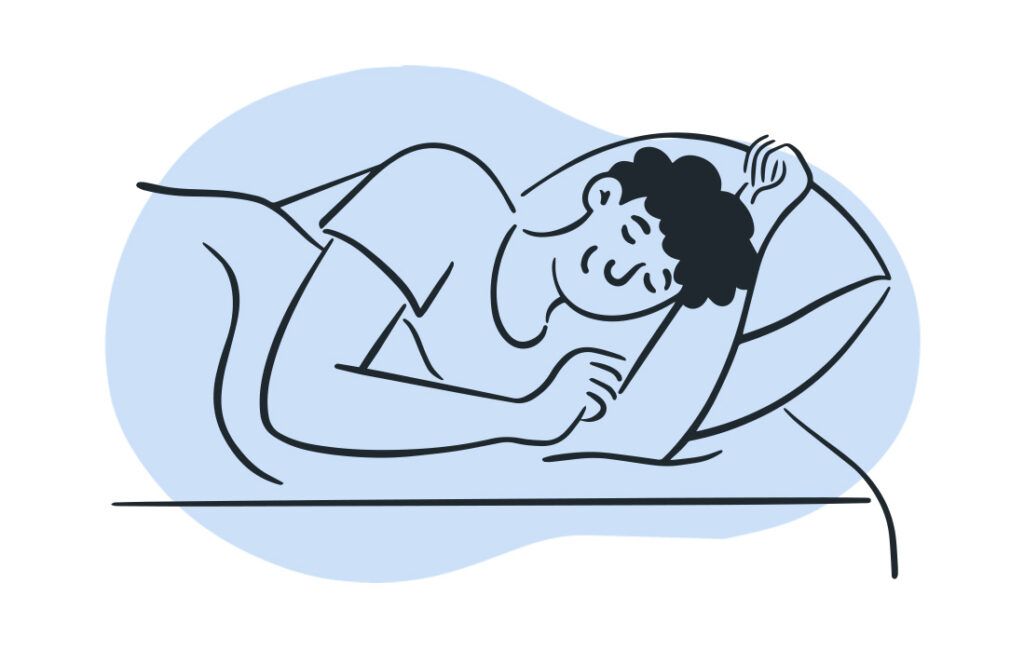How to Properly Sleep on Your Side
Disclosure: By clicking on the product links in this article, Mattress Nerd may receive a commission fee at no cost to you, the reader. Read full disclosure statement.
Side sleeping is popular—and doctor-recommend—for a reason. It’s generally the best position for everything from your airways to your body alignment, and it can even help alleviate some of the more irritating nighttime disorders (we’re looking at you, chronic snorers).
If you’ve been a lifelong advocate of stomach or back snoozing, it might be hard to make the switch. But with a few minor tweaks to your sleeping setup, you’ll be on your way to side-sleeping bliss in no time.
Sleeping on Left vs. Right Side
As a newbie side sleeper, you have one more decision to make before you hit the hay: which side should you sleep on? While the answer will likely be a matter of comfort or preference, there are some benefits specific to each side.
Benefits of sleeping on your left side
Sleeping on your left side may be better for heartburn and acid reflux, which is why pregnant people are often encouraged to adopt this position. Because your left side is dominant in your lymphatic system, some experts also recommend left-side sleeping as a way to improve digestion, though this has not been validated by any scientific studies.
Benefits of sleeping on your right side
Not all is lost for right-side sleepers. Studies show that sleeping on your right side helps relieve pressure on your heart, which is crucial for those who live with heart conditions like congestive heart failure. Researchers believe sleeping on your right side stabilizes your blood pressure and heart rate. So if you have any heart-related issues, this may be the best side for you to sleep.
Benefits of Side Sleeping
While there may be some side-specific benefits, the benefits of sleeping on your side in general are numerous.
Reduced Symptoms of Acid Reflux and Heartburn
If you’re a nightly victim of that awful burning sensation that comes with heartburn, acid reflux, and GERD, you know how difficult it is to get a good night’s sleep. And unfortunately, lying flat on your back or on your right side can make symptoms worse.
Rolling over to your left side and slightly elevating your head and torso via pillows may help reduce the frequency of heartburn by allowing gravity to keep stomach acid where it belongs
Reduced Snoring
Chronic snoring can make it difficult for both you and your partner to get a good night’s sleep, but it can also be a sign of a more serious condition like sleep apnea. If you’re struggling with snoring, side sleeping is your best bet.
Back sleeping makes it easier to snore with your tongue rolling back and blocking your airway. Side sleeping opens up your airway so you can breathe easily throughout the night.
Reduced Sleep Apnea
If your snoring is more than just an occasional nuisance—and is accompanied by other symptoms like gasping, choking, pauses in breathing, and excessive daytime sleepiness—you may have sleep apnea. Snoozing on your side (left or right) could help reduce the severity of sleep apnea by keeping your airway open and free from obstruction.
Improved Gut Health
Dealing with digestive issues like constipation or nausea? You might want to consider switching to side sleeping for gut health. When you sleep on your side, your intestines have an easier time digesting food, and waste moves more easily through your system. If you’re struggling with any kind of digestive issues, side sleeping may help get things moving—literally.
Boosts Brain Health
Believe it or not, your gut isn’t the only organ that produces waste—your brain has some gunk, too. And there’s evidence that side sleeping “may more effectively remove brain waste” than other sleeping positions. Reducing brain waste, in turn, also reduces your chance of developing neurological diseases like Alzheimer’s and Parkinson’s.

Is it Bad to Sleep on Your Side?
All of these side sleeping benefits might make side sleeping seem like the pinnacle of all sleeping positions, but it’s not all perfect. Just like any other sleep position, there are some potential drawbacks, such as:
- shoulder pain, particularly if you sleep on the same shoulder night after night
- hip stress and pain, especially if your mattress is too hard or too soft
- jaw discomfort, which could lead to headaches
- lower back pain
Luckily most (if not all) of these potentially painful side effects can be remedied with a few minor adjustments to your positioning or a mattress made for side sleepers.
How to Sleep on Your Side
If you’re ready to join the side-sleeping revolution, there are a few things you can do to make the transition as smooth and painless as possible:
- Pick the right pillow. If you’re a side sleeper, you need a pillow that’s thick enough to support—and slightly elevate—your head and neck so your spine stays in alignment. Anything too soft or too firm will likely cause pain in your neck and shoulders.
- Put a pillow between your knees. This will help take some of the pressure off of your hips and lower back.
- Watch out for your arm. Finding a comfortable arm placement can be the difference between a good night’s sleep and waking up with tingling in your fingers. Try placing the arm you’re lying on under your pillow or across your stomach for the best results. You can also try a body pillow for an extra snuggly feel.
How to Train Yourself to Sleep on Your Side

You may not fall in love with side sleeping overnight, and you might find yourself wanting to go back to your back or stomach. But with a little bit of perseverance (and maybe a little help from gravity), you can train yourself to sleep on your side.
- Try putting a pillow or even a tennis ball behind you for support and to train yourself to roll back. That way, you’ll either be blocked from rolling over, or it will be so uncomfortable that you’ll have to turn back onto your side.
- Try using a wedge pillow to prevent you from rolling onto your back.
- If you tend to roll onto your stomach, try holding a firm pillow (like a foam pillow) between your arms.
Keep at it, and eventually you should be able to wean yourself off the extra support and sleep on your side without a problem.
Final Thoughts
As it turns out, sleeping positions are more than just a matter of comfort—they could be the key to a good night’s sleep and a healthy body. So if you’re looking for a better way to sleep, try rolling onto your side. It might be just what you need to get the best sleep of your life.
Sources
Choosing the Best Sleeping Position. (2022). https://www.hopkinsmedicine.org/health/wellness-and-prevention/choosing-the-best-sleep-position
Could body posture during sleep affect how your brain clears waste? (2015). https://www.sciencedaily.com/releases/2015/08/150804203440.htm
Kaltenbach T, et al. (2006). Are Lifestyle Measures Effective in Patients With Gastroesophageal Reflux Disease? https://jamanetwork.com/journals/jamainternalmedicine/fullarticle/410292
Leung R, et al. (2003). Avoidance of the left lateral decubitus position during sleep in patients with heart failure: relationship to cardiac size and function. https://www.sciencedirect.com/science/article/pii/S0735109702027171
Heartburn Keeping You Up at Night? (2017). https://badgut.org/information-centre/a-z-digestive-topics/heartburn-keeping-night/
Howland J. (2022). Mayo Clinic Minute: What is the best sleeping position? https://newsnetwork.mayoclinic.org/discussion/mayo-clinic-minute-what-is-the-best-sleeping-position/
Snoring. (2017). https://www.mayoclinic.org/diseases-conditions/snoring/symptoms-causes/syc-20377694
Person E, et al. (2015). A Novel Sleep Positioning Device Reduces Gastroesophageal Reflux: A Randomized Controlled Trial. https://pubmed.ncbi.nlm.nih.gov/26053170/


